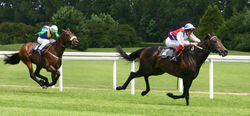thru many years i have watched in winter season many younger horses winning as favrites and debutants have won very well.
its better to watch mam and and ponawalas and d.khaitan and their connections for next season
Monday, October 30, 2006
my past racing experience for next racing season
hindu head line track work and real performance in horse racing
hi racing folks
i found that best track works wiining and placing at races see the record this is my analysis...
1.turbo babe at 2to one
2.sowerign power 1and quarter
3.oyster gem 3 to one
4. secret garden 3 to one
5.einstein 13 to one.
and many plced ones
1.the rising
2.torque place
i have been wating hindu and original vel for their selections and i noted that original wel is better and in most of the times its betting ring which is giving real trend...
next racing season in india,mumbai racing,bangalore racing,hyderabad racing,kolkata racing
i really want to know predictions by senior bloggers as how next season fares i want to have nice income for the season ahead i will eat and back if someone can give me nice tipping and i will pay them incentive too.
please join my blog and keep sending me your choices.
horse racing and science

Modern thoroughbred racing involves a science dilemma. The horses are bred for extreme speed, and a primary goal of this breeding has been to decrease bone mass while raising muscle mass, as a horse "carrying" a light skeleton using abnormally strong muscles will travel faster at a gallop than one with a heavier bone load. As a result, modern thoroughbreds are muscularly powerful but osteologically delicate creatures. Three out of every 2000 races result in a career-ending injury to one or more racers, typically due to broken leg bones; a ratio far in excess of almost all other human and animal sports. Of those injuries, more than 60% result in the horse being euthanized. Leg injuries, though not immediately fatal, are life-threatening because a horse's weight must be distributed evenly on all four legs to prevent circulatory problems, laminitis and other infections. If a horse loses the use of one leg, it cannot function; its other legs will quickly break down as well, leading to a slow death.
In the wake of the 2006 Preakness Stakes, in which Kentucky Derby winner Barbaro sustained severe fractures, there were signs that animal rights groups intended to target the thoroughbred racing industry. The bioethics are seldom clean-cut, however. While thoroughbreds are delicate and horse racing is hazardous, veterinary science is also developing, so that previously hopeless cases (such as Barbaro's) can now be treated successfully. Thoroughbreds are arguably [citation needed] as much helped as harmed by the racing industry, with the research in veterinary medicine, largely funded and driven by the industry.
Thoroughbred Racing
Thoroughbred Racing
Thoroughbred horses & horse racing. Horse racing has been a popular sport throughout the world for thousands of years now. In the modern-day United States, horse racing is the second biggest spectator sport as well as a widespread form of recreational gambling. The major forms of horse racing are Thoroughbred racing, harness racing, steeplechase racing, and quarter horse racing. In addition to major horse races like the Triple Crown, the Belmont Stakes, and the Kentucky Derby, there are horse races held every day during each season at such tracks as Gulfstream and Santa Anita. This section features resources on various topics relating to Thoroughbred horses.


